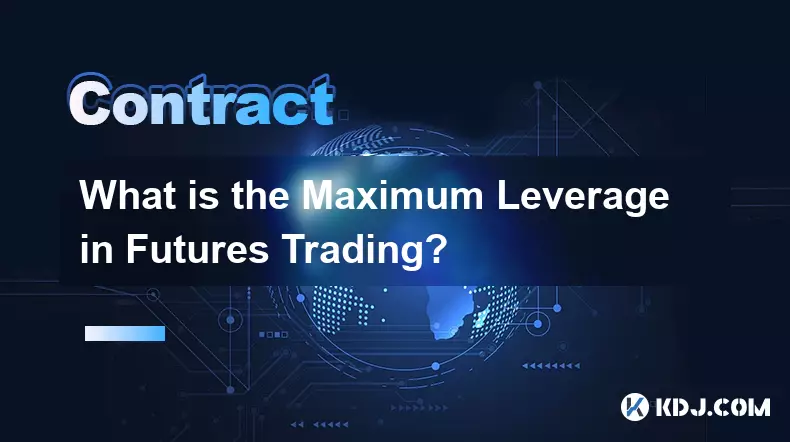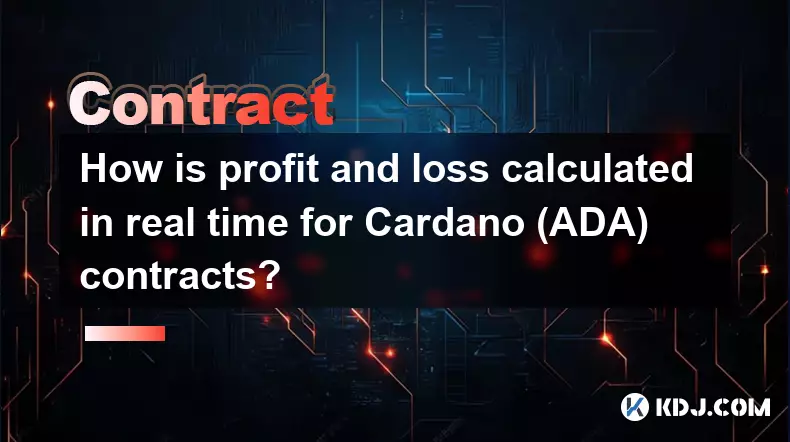-
 bitcoin
bitcoin $109667.069529 USD
-3.03% -
 ethereum
ethereum $3936.685804 USD
-4.07% -
 tether
tether $1.000493 USD
0.01% -
 xrp
xrp $2.771823 USD
-4.74% -
 bnb
bnb $957.805027 USD
-5.34% -
 solana
solana $196.735100 USD
-6.68% -
 usd-coin
usd-coin $0.999727 USD
-0.01% -
 dogecoin
dogecoin $0.227355 USD
-5.12% -
 tron
tron $0.335205 USD
-0.81% -
 cardano
cardano $0.779256 USD
-3.59% -
 ethena-usde
ethena-usde $0.999900 USD
-0.06% -
 hyperliquid
hyperliquid $42.492095 USD
-6.61% -
 chainlink
chainlink $20.501853 USD
-4.34% -
 avalanche
avalanche $28.952606 USD
-11.21% -
 stellar
stellar $0.356038 USD
-3.93%
What is the Maximum Leverage in Futures Trading?
Maximum leverage in crypto futures can reach 125x but increases liquidation risk; proper risk management and understanding exchange rules are crucial for traders.
Sep 23, 2025 at 01:19 am

Understanding Maximum Leverage in Futures Trading
1. In the cryptocurrency futures market, leverage allows traders to control a larger position with a smaller amount of capital. The maximum leverage varies significantly across different exchanges and specific trading pairs. Some platforms offer leverage as high as 125x on certain contracts, particularly for popular assets like Bitcoin and Ethereum.
2. High leverage amplifies both potential profits and losses. A 125x leverage means that a 0.8% move against a trader’s position could result in a complete liquidation. This extreme sensitivity makes risk management essential when utilizing such high levels of borrowing power.
3. Not all trading pairs support the same maximum leverage. Stablecoin-based pairs or less volatile altcoins may only allow up to 10x or 25x leverage due to their price behavior and associated risks. Exchanges adjust these limits based on volatility, liquidity, and overall market conditions.
4. Regulatory environments also influence leverage caps. Certain jurisdictions impose restrictions on how much leverage can be offered to retail traders. As a result, global platforms often implement region-specific settings to comply with local laws, which can reduce the maximum available leverage for users in regulated areas.
5. Traders should not assume that using the highest available leverage is optimal. Many experienced participants prefer lower leverage—such as 5x to 20x—to maintain longer positions and withstand market fluctuations without facing premature liquidation during normal volatility swings.
Risk Implications of High Leverage Usage
1. When employing maximum leverage, even minor price shifts can trigger stop-loss mechanisms or automatic liquidations. For instance, on a 100x leveraged long position, a 1% drop in asset value erases the entire margin balance, leading to total loss of the invested capital.
2. Liquidation engines on most futures platforms operate rapidly, especially during periods of high volatility. Once the maintenance margin threshold is breached, the system closes the position almost instantly, leaving little room for manual intervention or recovery.
3. High leverage increases dependency on precise entry and exit points. Traders relying on 50x or higher multipliers must time their trades accurately, making emotional decision-making more dangerous and increasing the likelihood of impulsive actions under pressure.
4. Funding rates in perpetual futures contracts become more impactful under high leverage. Over extended holding periods, the cumulative cost of paying or receiving funding can significantly affect profitability, especially when positions are sized aggressively relative to account equity.
Excessive leverage exposes traders to sudden market shocks, flash crashes, and slippage during low-liquidity events, turning otherwise manageable drawdowns into catastrophic losses.Exchange-Specific Leverage Policies
1. Leading derivatives exchanges such as Binance, Bybit, and OKX publish detailed leverage matrices that outline maximum levels per contract type. These matrices differentiate between isolated and cross-margin modes, where isolated margin lets traders limit exposure per position while cross-margin uses the entire balance as collateral.
2. Some exchanges dynamically adjust maximum leverage based on open interest and recent volatility metrics. During times of heightened uncertainty—like major macroeconomic announcements or protocol upgrades—the platform may temporarily reduce allowable leverage to mitigate systemic risk.
3. Tiered margin systems are commonly used to regulate access to high leverage. Users with larger account balances or verified professional status might qualify for higher limits, whereas new or unverified accounts face stricter caps regardless of the underlying instrument.
4. Customer support teams at major exchanges frequently emphasize that maximum leverage does not imply recommended leverage. Educational materials often highlight case studies where over-leveraged positions led to rapid depletion of funds despite correct directional predictions.
Transparency in leverage rules helps traders make informed decisions, but it remains the user's responsibility to understand the full implications before opening highly leveraged positions.Frequently Asked Questions
What happens when a leveraged position gets liquidated?A liquidation occurs when the margin supporting a futures position falls below the required maintenance level. The exchange automatically closes the position to prevent further losses, resulting in the partial or total loss of the initial margin. In some cases, insurance funds cover residual deficits, but traders typically lose their entire stake in the trade.
Can leverage be changed after entering a futures position?On most platforms, leverage cannot be adjusted once a position is open if using isolated margin mode. However, some exchanges allow leverage modification by increasing or decreasing the margin allocated to an existing position, effectively altering the risk ratio without closing the trade.
Is maximum leverage the same for long and short positions?Yes, the maximum leverage available is generally symmetrical for both long and short futures contracts. The same multiplier applies regardless of direction, though fees, funding rates, and liquidity may differ slightly between buying and selling sides depending on market sentiment.
Disclaimer:info@kdj.com
The information provided is not trading advice. kdj.com does not assume any responsibility for any investments made based on the information provided in this article. Cryptocurrencies are highly volatile and it is highly recommended that you invest with caution after thorough research!
If you believe that the content used on this website infringes your copyright, please contact us immediately (info@kdj.com) and we will delete it promptly.
- Hashdex, Crypto ETFs, XRP & Solana: A New Era for Digital Asset Investing
- 2025-09-26 18:25:12
- Crypto Market Slowdown? Year-End Rally Still in Play!
- 2025-09-26 18:25:12
- XRP, RLUSD, and the Derivatives Market: A New York Minute on Crypto's Next Big Thing
- 2025-09-26 18:45:15
- Bitcoin Price Under Pressure: Is $105,000 Still in Play?
- 2025-09-26 19:05:14
- Pepeto's Presale Surge: Riding the PEPE Success Wave?
- 2025-09-26 19:05:14
- Pepeto vs. Shiba Inu vs. PEPE: The Next Meme Coin Millionaire Maker?
- 2025-09-26 19:10:01
Related knowledge

How do I enable the "scalping-only" mode for Cardano (ADA) contracts?
Sep 24,2025 at 03:19am
Understanding Scalping Strategies in Crypto Derivatives1. Scalping in cryptocurrency trading refers to executing multiple short-term trades within min...

What is the maximum position limit for Cardano (ADA) contracts?
Sep 23,2025 at 11:00pm
Understanding ADA Futures and Derivatives Market Structure1. Cardano (ADA) futures contracts are offered by several major cryptocurrency derivatives e...

What is the maker fee for Cardano (ADA) contracts?
Sep 26,2025 at 09:01am
Understanding Maker Fees in Cardano (ADA) Contracts1. The concept of maker fees applies broadly across decentralized exchanges and smart contract plat...

How can I view open interest in Cardano (ADA) contracts?
Sep 24,2025 at 07:36am
Understanding Open Interest in Cardano Derivatives1. Open interest refers to the total number of outstanding derivative contracts, such as futures or ...

What is the function of the insurance fund in Cardano (ADA) contracts?
Sep 24,2025 at 02:18am
Understanding the Role of Insurance Funds in Cardano Smart Contracts1. The insurance fund within Cardano's ecosystem is not a native feature directly ...

How is profit and loss calculated in real time for Cardano (ADA) contracts?
Sep 26,2025 at 04:18pm
Understanding Real-Time Profit and Loss in Cardano (ADA) Contracts1. Real-time profit and loss (P&L) calculations for Cardano-based smart contracts re...

How do I enable the "scalping-only" mode for Cardano (ADA) contracts?
Sep 24,2025 at 03:19am
Understanding Scalping Strategies in Crypto Derivatives1. Scalping in cryptocurrency trading refers to executing multiple short-term trades within min...

What is the maximum position limit for Cardano (ADA) contracts?
Sep 23,2025 at 11:00pm
Understanding ADA Futures and Derivatives Market Structure1. Cardano (ADA) futures contracts are offered by several major cryptocurrency derivatives e...

What is the maker fee for Cardano (ADA) contracts?
Sep 26,2025 at 09:01am
Understanding Maker Fees in Cardano (ADA) Contracts1. The concept of maker fees applies broadly across decentralized exchanges and smart contract plat...

How can I view open interest in Cardano (ADA) contracts?
Sep 24,2025 at 07:36am
Understanding Open Interest in Cardano Derivatives1. Open interest refers to the total number of outstanding derivative contracts, such as futures or ...

What is the function of the insurance fund in Cardano (ADA) contracts?
Sep 24,2025 at 02:18am
Understanding the Role of Insurance Funds in Cardano Smart Contracts1. The insurance fund within Cardano's ecosystem is not a native feature directly ...

How is profit and loss calculated in real time for Cardano (ADA) contracts?
Sep 26,2025 at 04:18pm
Understanding Real-Time Profit and Loss in Cardano (ADA) Contracts1. Real-time profit and loss (P&L) calculations for Cardano-based smart contracts re...
See all articles










































































